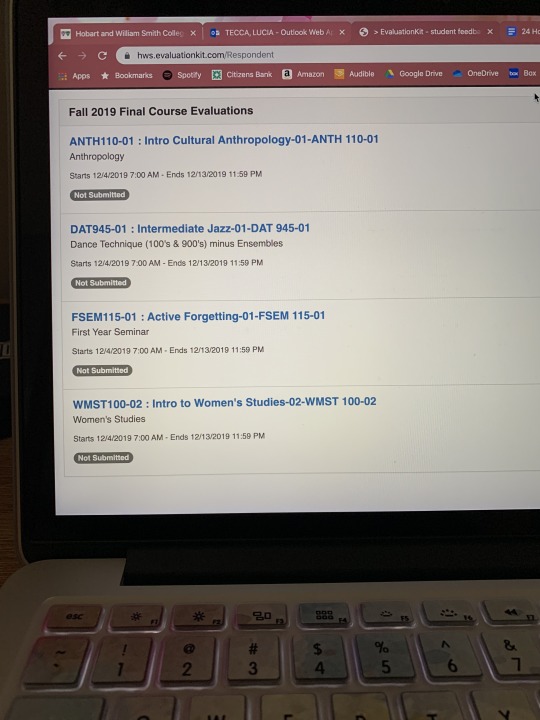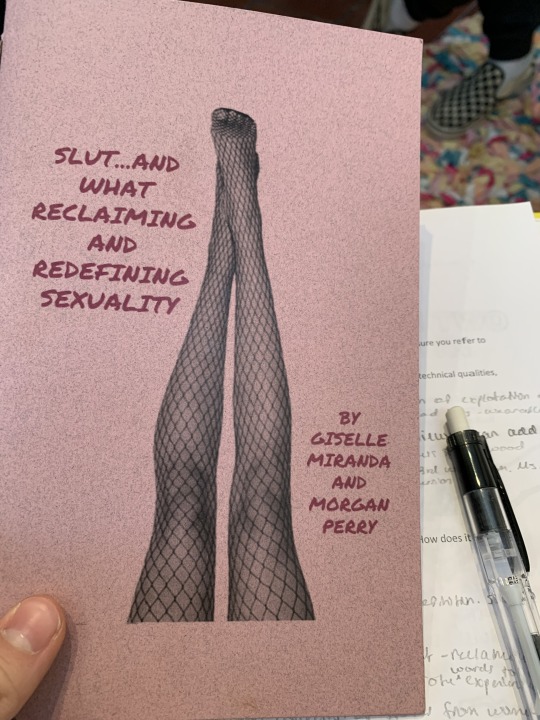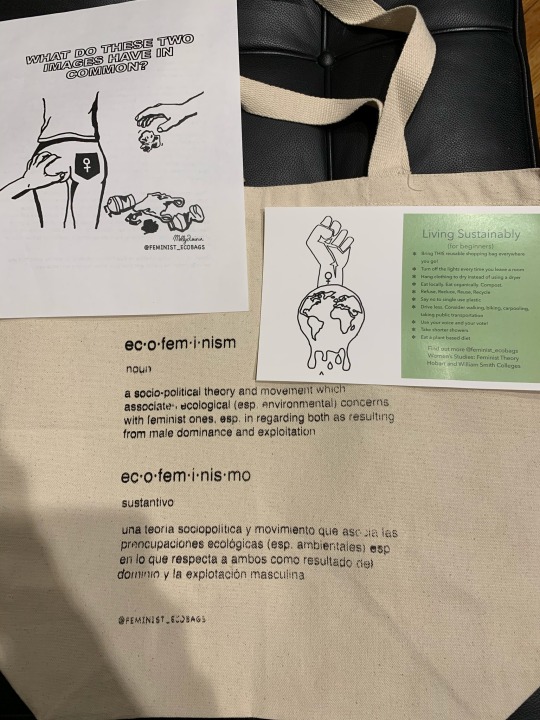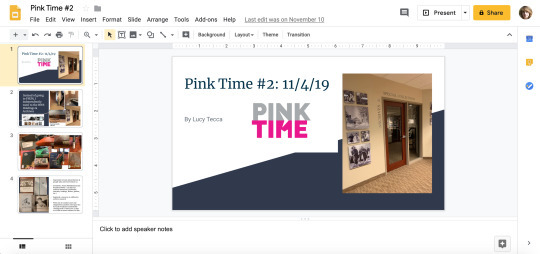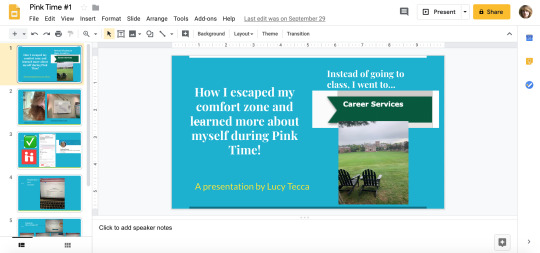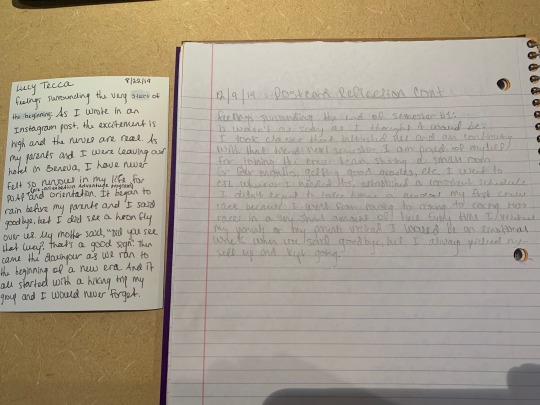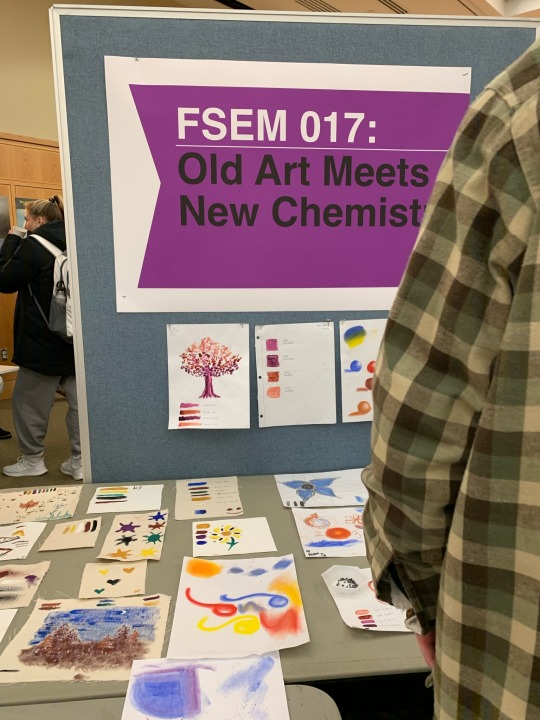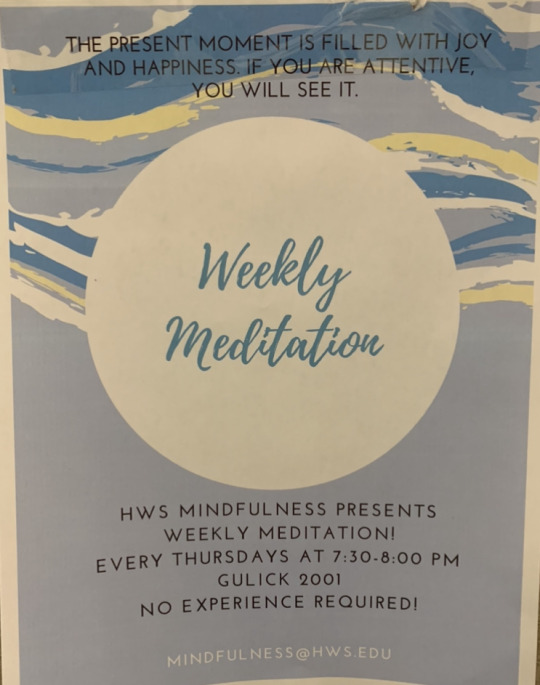Text
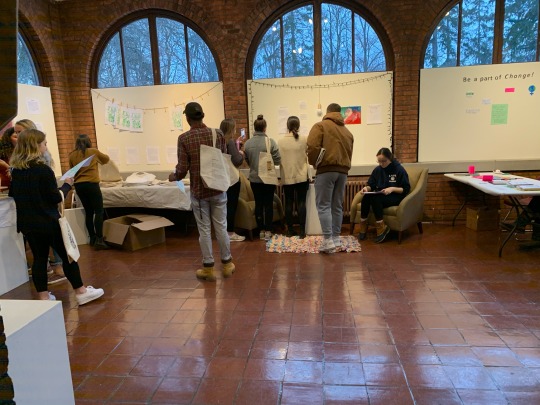
Feminist Toolkits for Feminist Futures showing at Houghton House Solarium Gallery yesterday afternoon.
0 notes
Text
Final Research Paper
Katie Paterson and the Concept of Memory
The purpose of my research is to study the work and practice of the artist Katie Paterson and how her work relates to the concept of memory. Paterson replicated her memories into her art works, taking what is inside of her to create her visible mediums, which include texts, monographs, videos, sculptures, images, numbers, etc. According to Ollivier Dyens in his article The Sadness of the Machine, “Memories of pleasure, pain, sadness and joy, are the common thread that unites all human beings. Memories are our existence, and art is their system of replication” (Dyens 2001, 77).
Born in Glasgow, Scotland in 1981 and currently based in Fyfe, UK, Paterson is one of the leading artists of her generation. She received her BA from the Edinburgh College of Art in 2004 and her MFA from the Slade School of Fine Art in London in 2007. She has since been the subject of solo exhibitions at institutions, recipient of the John Florent Stone Fellowship at Edinburgh College of Art, and was the Leverhulme Artist in Residence in the Astrophysics Group at the University College London from 2010 to 2011. She opened herself to different disciplines, but found it difficult to settle. She went between sculpture, fine art, and fashion then astronomy and geophysics. She stuck with art, cleverly incorporating science in her works. In collaboration with scientists and researchers from around the world, her projects consider the place of humans on planet Earth in the context of geological time and change. Her works utilize advanced technologies and expertise to display the engagements between people and the natural environment. The approach taken is Romantic and research-based, rigorous conceptualism and minimalism, shortens the distance between the viewer and the edges of time and the cosmos- essentially bringing said viewer closer to science through art. Paterson has broadcast the sounds of a melting glacier live, mapped dead stars, compiled a slide archive of darkness from the depths of the Universe, created a light bulb to simulate the experience of moonlight, and sent a recast meteorite back into space. She is fascinated by science and is known for her multidisciplinary and conceptually-driven work with an emphasis on nature, ecology, geology and cosmology. Her conceptual art finds everyday analogies for profound cosmological themes, is consistent in exploring scientific themes through contemporary art: her works have ranged from sending a "second moon" around the earth by courier service, to playing a record at the speed of the earth's rotation. Institutions approve of her art because it fits some deep need they have for art that is conceptual and intellectual. That combination allows museums and respectable prize givers to feel they are “down with the kids,” while also furthering their liberal mission to educate the public. Using technologies normally applied to the speed and scope of human experience, the Scottish artist zooms out or tunnels in to other, more alien dimensions, reframing natural and cosmic phenomena. Anthropocentric worldviews are dissipated in favor of a different kind of consciousness, one keyed to evolutionary systems and rooted in contact with igneous chaos. She makes use of sophisticated technologies and specialist expertise to stage intimate, poetic and philosophical engagements between people and their natural environment.“Eliciting feelings of humility, wonder and melancholy akin to the experience of the Romantic sublime, Paterson's work is at once understated in gesture and yet monumental in scope.” Paterson has exhibited internationally, from London to New York, Berlin to Seoul, and her works have been included in major exhibitions including Hayward Gallery, Tate Britain, Kunsthalle Wien, MCA Sydney, Guggenheim Museum, New York, and The Scottish National Gallery of Modern Art, Edinburgh. She was the winner of the Visual Arts category of the 2014 South Bank Awards, and is an Honorary Fellow of Edinburgh University. Her poetic installations have been the result of intensive research and collaboration with specialists as diverse as astronomers, geneticists, nanotechnologists, jewelers and firework manufacturers. As Erica Burton, curator at Modern Art Oxford, wrote at a solo exhibition in 2008, “Katie Paterson’s work engages with the landscape, as a physical entity and as an idea. Drawing on our experience of the natural world, she creates an expanded sense of reality beyond the purely visible.” In terms of inspiration, I would believe that her experience living in Iceland and around the world felt like visiting different planets. Traveling to drastically different places feels like visiting different worlds, which is what sparked her fascination with outer space and the cosmos.
Recent works: Totality (2016), a mirrorball reflecting every solar eclipse seen from earth; Hollow (2016), a commission for University of Bristol, made in collaboration with architects Zeller & Moye, permanently installed in the historic Royal Fort Gardens: a miniature forest of all the world’s forests, including over 10,000 unique tree species spanning millions of years telling the history of the planet through the immensity of tree specimens in microcosm; Fossil Necklace (2013), a necklace comprised of 170 carved, rounded fossils, spanning geological time; Second Moon (2013), a work that tracks the cyclical journey of a fragment of the moon as it circles the Earth, via airfreight courier, on a man-made year-long commercial orbit; All the Dead Stars (2009), a large map documenting the locations of 27,000 dead stars known to humanity; Light bulb to Simulate Moonlight (2009), an incandescent bulb designed to transmit wavelength properties identical to those of moonlight; and History of Darkness (ongoing), a slide archive of darkness captured at different times and places throughout the universe and spanning billions of years. “Paterson created Earth-Moon-Earth (Moonlight Sonata Reflected from the Surface of the Moon) (2007). With the assistance of radio operators Peter Blair in Southampton, England, and Peter Sundberg in Lulea, Sweden, Paterson bounced Morse code Signals of the score of the first movement of Beethoven’s Moonlight Sonata off the moon and then transcribed the echoed information back into notation, which was then played back in exhibition on a player piano… Paterson employs a novel subtractive sonification based on ever-present loss. Regular radar scans of the surface would employ much higher power and include repetitions to override error producing a refined data set that a conventional sonification strategy would then transform into music or another art of sound. Paterson’s approach is different. Just as one hears the Pacific Ocean leak into the off-timings of Nam June Paik’s version of Bach, in Earth-Moon-Earth you hear the moon in what Beethoven does not sound like.” In itself, the universe is creativity and we are connected to it as it is made of materials that are commonplace. After learning of the Earth-Moon-Earth technology, Paterson found herself imagining what messages she would wish to send while strolling under a full moon. Musicalization of dead silences consists of sound recordings of three Icelandic glaciers on records made of frozen meltwater from these glaciers are played until the records melt, mimicking the loss and silencing of their source. History of Darkness, 2010 are, “...essays a cosmically laconic take on astro physical discovery of the protocols of its recording. For the Dying Star Letters, Paterson is sent an email each time scientists note a star has been expired; she then writes a letter of condolence.”
From Sydney, Australia to New York and Scotland, Paterson’s artwork has been present in both major showings and collections. Those include the Hayward Gallery, Tate Britain, Kunsthalle Wien, The Modern Art Museum of Fort Worth, and the Museum of Contemporary Art, Sydney, Guggenheim, New York and the Scottish National Gallery of Modern Art, Edinburgh. She was the winner of the Independent’s Creative 30 award ‘for Britain’s most creative young person’ and most recently the winner of the Visual Arts category of the 2014 South Bank Sky Arts Awards and has been awarded with an Honorary Fellowship from the University of Edinburgh.
She has worked in collaboration with institutions of scientific research and space agencies to realize complex projects that consider disciplines like astrophysics from an artistic point of view. For example, Paterson and Simon Faithfull teamed up to make work that tests the very limits of the sphere of human activity and knowledge, and their conception of the environment as a vastly expanded field is made possible by new developments in technology and radical advances in scientific thinking and method. At the same time, the way in which their work is actually realised retains a keen sense of physical constraints and material conditions; they set themselves wilfully difficult tasks, and resolve them in ingenious, laborious, sometimes eccentric ways. Paterson describes her practice as interdisciplinary, exploring landscape, space and time using technology to integrate the everyday and the cosmic. Everyday technologies are linked with something more vast and untouchable- telephone calls to melting glaciers, maps of every single dead star, street lights flickering in time with lightning storms, and music reflected back from the moon. Additionally, Margaret Atwood was asked by Paterson to be a contributor to her centennial project, Future Library, 2014-2114, a work of art in the form of time travel. Atwood is convinced that the human race will still exist in a hundred years. She ponders, “How strange is it to think of my own voice--silent by then for a long time--suddenly being awakened, after a hundred years. What is the first thing that voice will say, as a not-yet-embodied hand draws it out of its container and opens it to the first page?” In this project, words are grown through the trees, each ring becoming a chapter in a book.
A Map of every dead star in the Universe--which ties closely to this FSEM--details the location of the 27,000 dead stars that have ever been observed and recorded in human history–and her map continues to grow with each dying star. In order to create her map, Paterson consulted with physicists, librarians, and archivists to compile a record of the stars that have been recorded and that have since faded away or exploded. In her project the boundary is fuzzy between life and death, between the end of one star and the beginning of another, and it invites us to examine how we remember and record the past. Since stars die every day, one would wonder how this project could ever be finished... all the dead stars combined would be the size of the Earth. I believe that this reminds us that nothing is ever “done.” We do not recall every bit of our memories, even if we think we do.
Bibliography
Larsen, Lars Bang. 2014. 1000 WORDS: Katie paterson and margaret atwood. Artforum International. 11, https://ezproxy.hws.edu/login?url=https://search.proquest.com/docview/1625101398?accountid=27680 (accessed October 16, 2019).
McKinnon, Dugal. "Dead Silence: Ecological Silencing and Environmentally Engaged Sound Art." Leonardo Music Journal 23 (2013): 71-74. http://www.jstor.org/stable/43832509.
Dillon, Brian. "Attention! Photography and Sidelong Discovery." In Aperture, No.
211, Curiosity (Summer 2013), pp. 25-31. Published in JSTOR.
Accessed October 29, 2019. https://www.jstor.org/stable/24473799.
Kahn, Douglas. Earth Sound Earth Signal : Energies and Earth Magnitude in the Arts. Berkeley: University of California Press, 2013. Accessed October 29, 2019. ProQuest Ebook Central.
"Message to the Moon: Katie Paterson's Life in Astronomy." Frieze. Last modified June 6, 2019. Accessed December 7, 2019. https://frieze.com/article/message-moon-katie-patersons-life-astronomy.
0 notes
Text

Erg Room Antics (there aren’t actually any antics that occur I just thought that the title would be funny).
As a coxswain, I am getting to know all the rowers on this crew team and learning how to use my voice to make calls and empower them. On the water, I sit in the ninth (tiny!) seat and steer the boat and I also have all the information for running the workout, the stroke ratings, distance, time, and splits (time it would take to pull 500 meters).
0 notes
Text
A video from Jazz class of a shoulder exercise I created with two other people yesterday.
0 notes
Text
Research Paper Draft #2
Katie Paterson and the Concept of Memory
The purpose of my research is to study the work and practice of the artist Katie Paterson and to see how her work relates to the concept of memory. That meaning how she replicated her memories into her art works and takes what is inside of her to create her visible mediums, which include texts, monographs, videos, sculptures, images, numbers, etc. She used light and dark colors together and separately, how she employed simplicity and a clean style. According to Ollivier Dyens in his article The Sadness of the Machine, “Memories of pleasure, pain, sadness and joy, are the common thread that unites all human beings. Memories are our existence, and art is their system of replication” (Dyens 2001, 77).
Born in Glasgow, Scotland in 1981, Paterson is one of the leading artists in her generation. She received her BA from the Edinburgh College of Art in 2004 and her MFA from the Slade School of Fine Art in London in 2007. She has since been the subject of solo exhibitions at institutions, recipient of the John Florent Stone Fellowship at Edinburgh College of Art, and was the Leverhulme Artist in Residence in the Astrophysics Group at the University College London in 2010-2011. She opened herself to different disciplines, but found it difficult to settle. She went between sculpture, fine art, and fashion then astronomy and geophysics. She stuck with art, but cleverly incorporated science in her works. In collaboration with scientists and researchers from around the world, her projects consider the place of humans on planet Earth in the context of geological time and change. Her words utilize advanced technologies and expertise to display the engagements between people and the natural environment. The approach taken is Romantic and research-based, rigorous conceptualism and minimalist, shortens the distance between the viewer and the edges of time and the cosmos. She has broadcast the sounds of a melting glacier live, mapped dead stars, compiled a slide archive of darkness from the depths of the Universe, created a light bulb to simulate the experience of moonlight, and sent a recast meteorite back into space. “Eliciting feelings of humility, wonder and melancholy akin to the experience of the Romantic sublime, Paterson's work is at once understated in gesture and yet monumental in scope.” (203). Paterson has exhibited internationally, from London to New York, Berlin to Seoul, and her works have been included in major exhibitions including Hayward Gallery, Tate Britain, Kunsthalle Wien, MCA Sydney, Guggenheim Museum, New York, and The Scottish National Gallery of Modern Art, Edinburgh. She was the winner of the Visual Arts category of the 2014 South Bank Awards, and is an Honorary Fellow of Edinburgh University. Her poetic installations have been the result of intensive research and collaboration with specialists as diverse as astronomers, geneticists, nanotechnologists, jewelers and firework manufacturers. As Erica Burton, curator at Modern Art Oxford, wrote at a solo exhibition in 2008, “Katie Paterson’s work engages with the landscape, as a physical entity and as an idea. Drawing on our experience of the natural world, she creates an expanded sense of reality beyond the purely visible.” In terms of inspiration, her experience living in Iceland felt like living on another planet. Traveling to drastically different places feels like going to different planets, which is what sparked her fascination with outer space and the cosmos.
Among recent works are: Totality (2016), a mirrorball reflecting every solar eclipse seen from earth; Hollow (2016), a commission for University of Bristol, made in collaboration with architects Zeller & Moye, permanently installed in the historic Royal Fort Gardens: a miniature forest of all the world’s forests, including over 10,000 unique tree species spanning millions of years telling the history of the planet through the immensity of tree specimens in microcosm; Fossil Necklace (2013), a necklace comprised of 170 carved, rounded fossils, spanning geological time; Second Moon (2013), a work that tracks the cyclical journey of a fragment of the moon as it circles the Earth, via airfreight courier, on a man-made year-long commercial orbit; All the Dead Stars (2009), a large map documenting the locations of 27,000 dead stars known to humanity; Light bulb to Simulate Moonlight (2009), an incandescent bulb designed to transmit wavelength properties identical to those of moonlight; and History of Darkness (ongoing), a slide archive of darkness captured at different times and places throughout the universe and spanning billions of years. “Paterson created Earth-Moon-Earth (Moonlight Sonata Reflected from the Surface of the Moon) (2007). With the assistance of radio operators Peter Blair in Southampton, England, and Peter Sundberg in Lulea, Sweden, Paterson bounced Morse code Signals of the score of the first movement of Beethoven’s Moonlight Sonata off the moon and then transcribed the echoed information back into notation, which was then played back in exhibition on a player piano” (204). “Paterson employs a novel subtractive sonification based on ever-present loss. Regular radar scans of the surface would employ much higher power and include repetitions to override error producing a refined data set that a conventional sonification strategy would then transform into music or another art of sound. Paterson’s approach is different. Just as one hears the Pacific Ocean leak into the off-timings of Nam June Paik’s version of Bach, in Earth-Moon-Earth you hear the moon in what Beethoven does not sound like” (208). Musicalization of dead silences consists of sound recordings of three Icelandic glaciers on records made of frozen meltwater from these glaciers are played until the records melt, mimicking the loss and silencing of their source. History of Darkness, 2010 are, “...essays a cosmically laconic take on astro physical discovery of the protocols of its recording. For the Dying Star Letters, Paterson is sent an email each time scientists note a star has been expired; she then writes a letter of condolence” (31).
Paterson is reputable for being fascinated by science and is known for her multidisciplinary and conceptually-driven work with an emphasis on nature, ecology, geology and cosmology. Strong political standpoint: yes for independent Scotland. Her conceptual art finds everyday analogies for profound cosmological themes, is consistent in exploring scientific themes through contemporary art: her works have ranged from sending a "second moon" around the earth by courier service, to playing a record at the speed of the earth's rotation. Institutions approve of her art because it fits some deep need they have for art that is conceptual and intellectual. That combination allows museums and respectable prize givers to feel they are “down with the kids,” while also furthering their liberal mission to educate the public.“The Works of Katie Paterson go sailing off the scale of civilization. Using technologies normally applied to the speed and scope of human experience, the Scottish artist zooms out or tunnels in to other, more alien dimensions, reframing natural and cosmic phenomena… anthropocentric worldviews are dissipated in favor of a different kind of consciousness, one keyed to evolutionary systems and rooted in contact with igneous chaos.” “Her poetic and conceptual projects consider our place on Earth in the context of geological time and change. She makes use of sophisticated technologies and specialist expertise to stage intimate, poetic and philosophical engagements between people and their natural environment. Paterson has exhibited in major shows including the Hayward Gallery, Tate Britain, Kunsthalle Wien, The Modern Art Museum of Fort Worth, and the Museum of Contemporary Art, Sydney. Her artworks are represented in collections, including the Guggenheim, New York and the Scottish National Gallery of Modern Art, Edinburgh. She was the winner of the Independent’s Creative 30 award ‘for Britain’s most creative young person’ and most recently the winner of the Visual Arts category of the 2014 South Bank Sky Arts Awards. Paterson was also awarded an Honorary Fellowship at Edinburgh University in recognition of her ‘major contribution in fostering collaboration between the arts and sciences” (Tate.org).
She has worked in collaboration with institutions of scientific research and space agencies to realize complex projects that consider disciplines like astrophysics from an artistic point of view. For example, Paterson and Simon Faithfull make work that tests the very limits of the sphere of human activity and knowledge, and their conception of the environment as a vastly expanded field is made possible by new developments in technology and radical advances in scientific thinking and method. At the same time, the way in which their work is actually realised retains a keen sense of physical constraints and material conditions; they set themselves wilfully difficult tasks, and resolve them in ingenious, laborious, sometimes eccentric ways. Paterson describes her practice as, “cross-medium and multi-disciplinary, often exploring landscape, space and time, using technology to bring together the commonplace and the cosmic. Everyday technologies – phones, record players, radio – connecting with something vaster, more intangible: telephone calls to melting glaciers, maps of all the dead stars, streetlights which flicker in time with lightning storms, music reflected from the moon” (Tate.org). Additionally, Margaret Atwood was asked by Paterson to be a contributor to her centennial project, Future Library, 2014-2114, a work of art in the form of time travel. Atwood is convinced that the human race will still exist in a hundred years.
A Map of every dead star in the Universe--which ties closely to this FSEM--details the location of the 27,000 dead stars that have ever been observed and recorded in human history–and her map continues to grow with each dying star. In order to create her map, Paterson consulted with physicists, librarians, and archivists to compile a record of the stars that have been recorded and that have since faded away or exploded. In her project the boundary is fuzzy between life and death, between the end of one star and the beginning of another, and it invites us to examine how we remember and record the past.“But with stars dying every day, could a project like this ever be completed? If Paterson were to make a map of every dead star then it would be the size of the Earth itself. There’s also the impossibility of the task as it is ultimately infinite—why would an artist begin an artwork that is impossible to finish and with no foreseeable end?” (Tate.org).
Notes from writing fellow meeting in CTL:
- Smooth everything over, try not to list points too much
- Check for spelling/grammar and wording
- Make sure paragraphs flow nicely- add transitions?
- Make sure to properly cite quotations/information
- Add my own analysis, have a clearer focus
Bibliography
Murphy, Kate. "Katie Paterson." The New York Times Sunday Review. Last modified September 20, 2014. Accessed October 20, 2019. https://www.nytimes.com/2014/ 09/21/opinion/sunday/katie-paterson.html?searchResultPosition=1.
Larsen, Lars Bang. 2014. 1000 WORDS: Katie paterson and margaret atwood. Artforum International. 11, https://ezproxy.hws.edu/login?url=https://search.proquest.com/docview/1625101398?accountid=27680 (accessed October 16, 2019).
McKinnon, Dugal. "Dead Silence: Ecological Silencing and Environmentally Engaged Sound Art." Leonardo Music Journal 23 (2013): 71-74. http://www.jstor.org/stable/43832509.
Dillon, Brian. "Attention! Photography and Sidelong Discovery." In Aperture, No.
211, Curiosity (Summer 2013), pp. 25-31. Published in JSTOR.
Accessed October 29, 2019. https://www.jstor.org/stable/24473799.
Kahn, Douglas. Earth Sound Earth Signal : Energies and Earth Magnitude in the Arts. Berkeley: University of California Press, 2013. Accessed October 29, 2019. ProQuest Ebook Central.
https://www.tate.org.uk/search?q=Katie+Paterson
0 notes
Text
Research Paper Draft #1
Katie Paterson and the Concept of Memory
The purpose of my research is to study the work and practice of the artist Katie Paterson and to see how her work relates to the concept of memory- how she replicated her memories into her art works and takes what is inside of her to create her visible mediums, which include texts, monographs, videos, sculptures, images, numbers, etc. She used light and dark colors together and separately, how she employed simplicity and a clean style. According to Ollivier Dyens in his article The Sadness of the Machine, “Memories of pleasure, pain, sadness and joy, are the common thread that unites all human beings. Memories are our existence, and art is their system of replication” (Dyens 2001, 77).
Basic biographical information/identity as an artist and a person:
Born in Glasgow, Scotland in 1981, one of the leading artists in her generation. Received her BA from Edinburgh College of Art, Edinburgh, United Kingdom in 2004 and her MFA from the Slade School of Fine Art in London, United Kingdom in 2007. She has since been the subject of solo exhibitions at institutions, recipient of the John Florent Stone Fellowship at Edinburgh College of Art, and was the Leverhulme Artist in Residence in the Astrophysics Group at the University College London in 2010-2011. In collaboration with scientists and researchers from around the world, her projects consider the place of humans on planet Earth in the context of geological time and change. Her words utilize advanced technologies and expertise to display the engagements between people and the natural environment. Approach is Romantic and research-based, rigorous conceptualism and minimalist, shortens the distance between the viewer and the edges of time and the cosmos. She has broadcast the sounds of a melting glacier live, mapped dead stars, compiled a slide archive of darkness from the depths of the Universe, created a light bulb to simulate the experience of moonlight, and sent a recast meteorite back into space. “Eliciting feelings of humility, wonder and melancholy akin to the experience of the Romantic sublime, Paterson's work is at once understated in gesture and yet monumental in scope.” Paterson has exhibited internationally, from London to New York, Berlin to Seoul, and her works have been included in major exhibitions including Hayward Gallery, Tate Britain, Kunsthalle Wien, MCA Sydney, Guggenheim Museum, New York, and The Scottish National Gallery of Modern Art, Edinburgh. She was the winner of the Visual Arts category of the 2014 South Bank Awards, and is an Honorary Fellow of Edinburgh University. Her poetic installations have been the result of intensive research and collaboration with specialists as diverse as astronomers, geneticists, nanotechnologists, jewelers and firework manufacturers. As Erica Burton, curator at Modern Art Oxford, wrote at a solo exhibition in 2008, “Katie Paterson’s work engages with the landscape, as a physical entity and as an idea. Drawing on our experience of the natural world, she creates an expanded sense of reality beyond the purely visible.”
Her artistic creations:
Among recent works are: Totality (2016), a mirrorball reflecting every solar eclipse seen from earth; Hollow (2016), a commission for University of Bristol, made in collaboration with architects Zeller & Moye, permanently installed in the historic Royal Fort Gardens: a miniature forest of all the world’s forests, including over 10,000 unique tree species spanning millions of years telling the history of the planet through the immensity of tree specimens in microcosm; Fossil Necklace (2013), a necklace comprised of 170 carved, rounded fossils, spanning geological time; Second Moon (2013), a work that tracks the cyclical journey of a fragment of the moon as it circles the Earth, via airfreight courier, on a man-made year-long commercial orbit; All the Dead Stars (2009), a large map documenting the locations of 27,000 dead stars known to humanity; Light bulb to Simulate Moonlight (2009), an incandescent bulb designed to transmit wavelength properties identical to those of moonlight; and History of Darkness (ongoing), a slide archive of darkness captured at different times and places throughout the universe and spanning billions of years.
“Paterson created Earth-Moon-Earth (Moonlight Sonata Reflected from the Surface of the Moon) (2007). With the assistance of radio operators Peter Blair in Southampton, England, and Peter Sundberg in Lulea, Sweden, Paterson bounced Morse code Signals of the score of the first movement of Beethoven’s Moonlight Sonata off the moon and then transcribed the echoed information back into notation, which was then played back in exhibition on a player piano” (204).
“Paterson employs a novel subtractive sonification based on ever-present loss. Regular radar scans of the surface would employ much higher power and include repetitions to override error producing a refined data set that a conventional sonification strategy would then transform into music or another art of sound. Paterson’s approach is different. Just as one hears the Pacific Ocean leak into the off-timings of Nam June Paik’s version of Bach, in Earth-Moon-Earth you hear the moon in what Beethoven does not sound like” (208).
Musicalization of dead silences- Sound recordings of three Icelandic glaciers on records made of frozen meltwater from these glaciers are played until the records melt, mimicking the loss and silencing of their source.
History of Darkness, 2010: “...essays a cosmically laconic take on astro physical discovery of the protocols of its recording. For the Dying Star Letters, Paterson is sent an email each time scientists note a star has been expired; she then writes a letter of condolence” (31).
Paterson praises the book,“Stone Mattress,” by Margaret Atwood, our first author for “Future Library.” (Paterson herself says) I love her work because she can speak through generations and time. I’m also reading “Invisible Cities,” by Italo Calvino, which is a collection of texts that imagines cities of all varieties made of bizarre materials. And “The Blue Fox,” by the Icelandic author Sjon. You follow a blue fox through a hunted journey. It’s like a fairy tale. All three books travel through time and space. And they all have very poetic language as well.
Paterson addresses her political standpoint by saying, “I was following the Scottish referendum on BBC Scotland, Yes Scotland and the Wee Blue Book Mobile Edition. I submitted my vote: Yes for an independent Scotland. I think we will see positive results from the referendum, even though the result is not what I had hoped for.”
Inspirations/influences:
Her experience living in Iceland felt like living on another planet- traveling to drastically different places feels like going to different planets, which is what sparked her fascination with outer space and the cosmos.
Reputation as an artist:
She is fascinated by science and is known for her multidisciplinary and conceptually-driven work with an emphasis on nature, ecology, geology and cosmology. Her conceptual art finds everyday analogies for profound cosmological themes, is consistent in exploring scientific themes through contemporary art: her works have ranged from sending a "second moon" around the earth by courier service, to playing a record at the speed of the earth's rotation. Institutions approve of her art because it fits some deep need they have for art that is conceptual and intellectual. That combination allows museums and respectable prize givers to feel they are “down with the kids,” while also furthering their liberal mission to educate the public.“The Works of Katie Paterson go sailing off the scale of civilization. Using technologies normally applied to the speed and scope of human experience, the Scottish artist zooms out or tunnels in to other, more alien dimensions, reframing natural and cosmic phenomena… anthropocentric worldviews are dissipated in favor of a different kind of consciousness, one keyed to evolutionary systems and rooted in contact with igneous chaos.”
Working and collaborating with others:
"You, at least, believe that the human race will still be around in a hundred years!" enthused the acclaimed writer and environmental activist Margaret Atwood when she was asked to be the first contributor to Paterson's centennial project, Future Library, 2014-2114, a work of art that is essentially a form of time travel.”
Focusing on a single work and how it ties to our FSEM/memory:
Fossil Necklace, a giant circular string displaying the development of life on Earth. It is made of 170 carved fossil beads representing the Earth’s memory of a major occurrence in evolution through geological time. According to Paterson, “Fossil hunting is a new hobby of mine. It happened because I made a necklace of 170 beads carved from fossils and it charts all of geological time on Earth. The first bead is 3 1/2 billion years old and contains the first cellular life on earth and it goes on from there. I had no experience in paleontology and it took ages to work out what I was looking for. Scotland has got an amazing coast where you can find fossils just on the beach. I didn’t know this at all. I also got fossils from fairs, eBay and auctions.”
Campo del Cielo, Field of the Sky, 2012- may work with memory concept better (see video on James Cohan site).
Suggestions from the writing fellow: I met with Emma Consoli this past Sunday and 5pm. I had a positive experience in the CTL with her because she liked the way I outlined my first draft, but she did tell me to cut down on the raw quotations and use more of my own voice. She had me change my wording of phrases here and there and pointed out some grammatical errors from when I first typed out the draft.
Bibliography
Murphy, Kate. "Katie Paterson." The New York Times Sunday Review. Last modified September 20, 2014. Accessed October 20, 2019. https://www.nytimes.com/2014/ 09/21/opinion/sunday/katie-paterson.html?searchResultPosition=1.
Larsen, Lars Bang. 2014. 1000 WORDS: Katie paterson and margaret atwood. Artforum International. 11, https://ezproxy.hws.edu/login?url=https://search.proquest.com/docview/1625101398?accountid=27680 (accessed October 16, 2019).
McKinnon, Dugal. "Dead Silence: Ecological Silencing and Environmentally Engaged Sound Art." Leonardo Music Journal 23 (2013): 71-74. http://www.jstor.org/stable/43832509.
Dillon, Brian. "Attention! Photography and Sidelong Discovery." In Aperture, No.
211, Curiosity (Summer 2013), pp. 25-31. Published in JSTOR.
Accessed October 29, 2019. https://www.jstor.org/stable/24473799.
Kahn, Douglas. Earth Sound Earth Signal : Energies and Earth Magnitude in the Arts. Berkeley: University of California Press, 2013. Accessed October 29, 2019. ProQuest Ebook Central.
0 notes
Text
Memory Video Artist Statement
Artist Statement for Boating & The Cows of Prudence Island
Not necessarily inspired by any other artist, the motivation behind my video is a highly personal one- the exploration of the ideas of family, togetherness, as well as the importance of embracing the beauty of the ocean, shore, sky, and fresh air. In the vast majority of memories I have, I am with my family unit, that being my mother, father, myself, and our dog(s). I want the audience--Professor Kaplan and my classmates in FSEM--to see my connection to my family through an activity do together every year on our Freedom ‘35. The viewers should also see a small, specific memory that occurred seven years ago when we took the boat out to one of our usual spots, Potter’s Cove, where we encounter cows that follow us down a path. My father has recently put together an album collection of older photos and videos, many of which are of us as a family and included footage of the specific memory- one could ask whether there are more images or footage of our boating excursions or about the symbolic significance of sailboats, which can carry us not only to new places, but to new memories as well. I may be different from other artists using the subject matter of sailing because of how heavily connected to family it is for me. Others may sail on their own or do it as a team sport and show the importance of sailing as a team, which can be similar to sailing as a family.
0 notes
